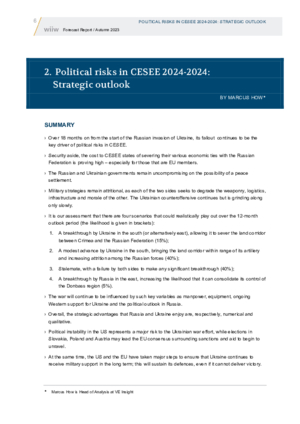wiiw Forecast Reports
Political risks in CESEE 2024-2024: Strategic outlook
Marcus How
in: Beneath the Veneer of Calm
wiiw Forecast Report No. Autumn 2023, October 2023 , pp. 6-17
Over 18 months on from the start of the Russian invasion of Ukraine, its fallout continues to be the key driver of political risks in CESEE. Security aside, the cost to CESEE states of severing their various economic ties with Russia is proving high – especially for those that are EU members. The Russian and Ukrainian governments remain uncompromising on the possibility of a peace settlement. Military strategies remain attritional, as each of the two sides seeks to degrade the weaponry, logistics, infrastructure and morale of the other. The Ukrainian counteroffensive continues but is grinding along only slowly. Political instability in the US represents a major risk to the Ukrainian war effort, while elections in Slovakia, Poland and Austria may lead the EU consensus surrounding sanctions and aid to begin to unravel. At the same time, the US and the EU have taken major steps to ensure that Ukraine continues to receive military support in the long term; this will sustain its defences, even if it cannot deliver victory.
Reference to wiiw databases: wiiw Annual Database, wiiw Monthly Database
Countries covered: Albania, Austria, Belarus, Bosnia and Herzegovina, Bulgaria, Central and East Europe, CESEE, China, CIS, Croatia, Czechia, Estonia, Euro Area, European Union, Hungary, Israel, Japan, Kazakhstan, Kosovo, Latvia, Lithuania, Moldova, Montenegro, New EU Member States, North Macedonia, Poland, Romania, Russia, Serbia, Slovakia, Slovenia, Southeast Europe, Turkey, Ukraine, US, Western Balkans
Research Areas: Macroeconomic Analysis and Policy, International Trade, Competitiveness and FDI
